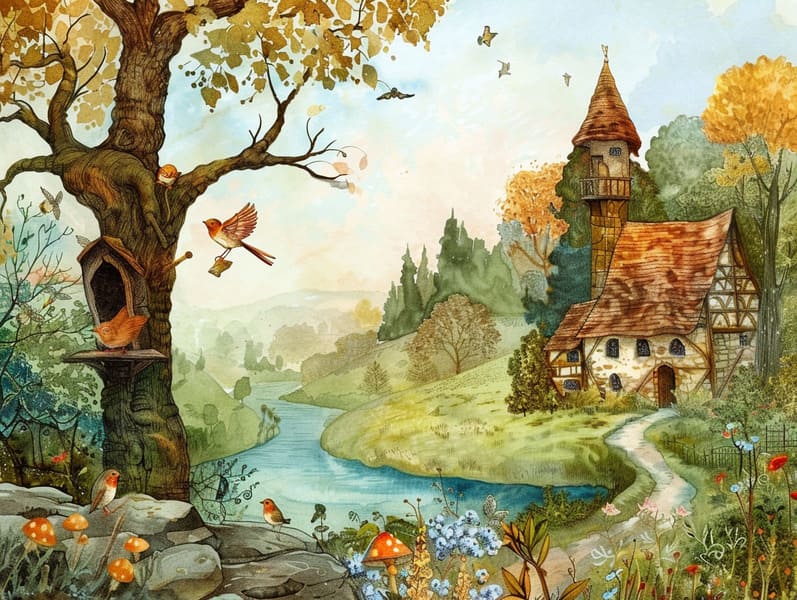Understanding the Legacy of Best Fairy Tales and the Consistent Charm.
Understanding the Legacy of Best Fairy Tales and the Consistent Charm.
Blog Article

Old fairy tales have old origins. These stories have been conveyed from one generation to the next long before they were ever transcribed. They originated from a variety of traditions, including Indigenous traditions. They were initially disseminated among adults, often carrying themes and messages concerning the societal norms and beliefs of the time.
The famous Grimm duo, Jacob and Wilhelm, were among the first to compile and release many of these beloved fairy tales. Their anthology, "Grimm's Folk Tales," included narratives like "Cinder Maid," "Hansel and Grethel," and "Snow White," which have since become staples in the world of classic fairy tales. Similarly, H. C. Andersen's magical stories, such as "The Little Mermaid," and "The Little Duckling," have floated into hearts worldwide, solidifying their place in the pantheon of classic fairy tales.
Despite their ancient origins, fairy tales remain as impactful as ever, especially as children's night stories. These fantastical tales are now available in different formats, including gorgeously illustrated books, captivating animations, and digital fairy tales.
Their lasting presence can be connected to several magical reasons:
Life Lessons: Traditional fairy tales often whisper important moral lessons. Tales like "The Story of the Boy Who Cried Wolf" teach the benefit of truthfulness, while "The Story of the Tortoise and the Hare" demonstrate the virtues of steadfastness and unassuming nature. These narratives offer children clear distinctions between correct and incorrect, shaping their moral compass in a gentle yet significant way.
Empathy and Awareness: Fairy tales frequently involve characters facing trials and tribulations, provoking young readers to understand with their struggles and back their triumphs. For instance, "The Tale of Beauty and the Beast" demonstrates the necessity of valuing inner qualities to appreciate the inner core of a character, developing kindness and knowledge.
Cultural Knowledge: Many timeless fairy tales are imbued with the cultural contexts from which they originated. Exploring these narratives can provide captivating looks into different heritages, advancing a sense of global respect and perception.
Fantasy and Innovation: The fantasy-filled elements in classic fairy tales—magical beings—generate children’s creative dreams. These tales guide readers to supernatural realms, awakening innovative ideas and a sense of mystery that persists a lifetime.
Old fairy tales are not only bewitching but also educational. They function as magical tools in advancing various intellectual and emotional capacities in little ones. When ancient fairy tales are voiced, they improve communication skills by showing new vocabulary and complex sentence structures. This practice also nurtures listening skills and attention span, as kids remain attentive, enthusiastic to see what happens next.
Furthermore, reflecting on the themes and characters of traditional fairy tales can enhance thought processes and intellectual skills. Kids are guided to detect patterns, anticipate outcomes, and make sense of cause and effect. These debates also facilitate little ones express their thoughts and feelings, nurturing their emotional intelligence.
In today’s modern era, the availability of internet fairy tales has made these fairy tales more obtainable than ever. Web-based platforms and programs give vast collections of old fairy tales that can be seen or heard anytime, anywhere. Fairy tales read out loud are particularly widespread, sharing an interactive way for young ones to immerse in these magical stories. Audiobooks and read-to-me videos transport characters and settings to life, often supported by mesmerizing background sounds and music that elevate the story adventure.
The enduring charm of traditional fairy tales lies in their ability to modify to present days while continuing with their fundamental ideas. Contemporary retellings of these fairy tales often incorporate more representative characters and modern settings, making them pertinent to today’s audience. However, the core values of courage, compassion, and rightness remain unchanged, continuing to influence children of all ages.
Traditional fairy tales also offer a sense of warmth and understanding. They make accessible a systematic narrative with a transparent beginning, middle, and end, often winding up with the conclusion of conflicts and the triumph of righteousness over wickedness. This uniformity can be encouraging for little ones, presenting a sense of dependability in an fluctuating world.
Ancient fairy tales continue to bewitch and teach new generations, maintaining their grace and importance in modern society. As kids' bedtime tales, they furnish a perfect blend of charm and enlightenment, backing moral values, empathy, here and creativity. The accessibility of online storybooks and the sought after status of fairy tales narrated assure that these ancient fairy tales remain obtainable to new generations.
By protecting and circulating these tales, we continue to celebrate the rich tapestry of inventiveness and cultural heritage. Whether you are exploring a vividly illustrated book, browsing a online collection, or playing an narrated book, the fascination of old fairy tales is always within reach. These narratives show us of the persistent influence of narratives and its ability to bind us across eras and regions.
Be it you are enjoying a richly illustrated book, discovering a web collection, or hearing an audiobook, the wonder of ancient fairy tales is always within reach.
These tales point out of the unceasing influence of fairy tales and its ability to hold us together across time and space, creating a bond that charms and informs alike.